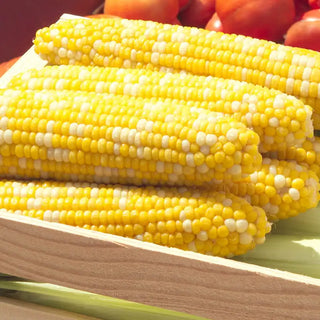Our bulk corn seed collection is designed to meet the demands of both large-scale agricultural operations and passionate hobbyists, offering high-quality seeds that promise excellent germination rates, vigorous growth, and bountiful yields. At Gurney's, we take pride in our extensive variety of corn seeds, each carefully selected and tested to ensure optimal performance in diverse growing conditions. Whether you're planting for commercial purposes or home gardens, our premium bulk corn seeds are the foundation for a successful and productive growing season. Explore our offerings and let Gurney's be your partner in planting prosperity and cultivating excellence.
Our bulk corn seeds are selected for their superior quality, high germination rates, and resilience, ensuring you achieve the best possible yield.
How to Plant Corn Seed in Bulk
Planting corn seed in bulk requires careful preparation and execution to ensure optimal growth and a bountiful harvest. Follow these steps for successful bulk corn planting:
- Prepare the Soil:
- Choose a well-drained, fertile location that receives full sun.
- Test the soil pH; corn prefers a pH between 6.0 and 6.8.
- Amend the soil with organic matter or compost to enhance fertility.
- Till the soil to a depth of 6-8 inches to loosen it and remove any weeds or debris.
- Plan Your Layout:
- For large-scale planting, consider using a mechanical planter for efficiency.
- Space rows 30-36 inches apart to allow ample room for growth and access.
- Within rows, space seeds 8-12 inches apart. This can be adjusted based on the specific variety and its growth habits.
- Planting the Seeds:
- Plant seeds 1-2 inches deep into the soil.
- If using a planter, ensure it is calibrated for the correct depth and spacing.
- For manual planting, create furrows and place seeds accordingly, then cover them with soil.
- Watering and Fertilizing:
- Water the seeds immediately after planting to settle the soil and encourage germination.
- Keep the soil consistently moist but not waterlogged during the growing season.
- Apply a balanced fertilizer at planting time and again when plants reach knee height. Follow specific fertilizer recommendations based on soil tests and corn variety.
- Maintenance:
- Monitor for pests and diseases regularly and take appropriate action if needed.
- Weed the rows and in between rows to reduce competition for nutrients and water.
- Thin the plants if they are too crowded to ensure adequate space for growth.
- Harvesting:
- Harvest when the corn ears are fully mature. The kernels should be firm and the husks should dry out.
- For large-scale operations, mechanical harvesters can efficiently collect the ears.
Ideal Corn Seed Growing Conditions
Here are the ideal corn seed growing conditions:
- Soil Requirements:
- Type: Corn prefers well-drained, loamy soil rich in organic matter.
- pH Level: Ideal soil pH is between 6.0 and 6.8.
- Preparation: Amend soil with compost or organic matter to improve fertility and texture. Ensure the soil is tilled to a depth of 6-8 inches to promote root development.
- Sunlight:
- Corn requires full sun to thrive. Ensure the planting area receives at least 6-8 hours of direct sunlight daily.
- Temperature:
- Corn is a warm-season crop. The optimal soil temperature for seed germination is between 60°F and 65°F (15.5°C and 18.3°C).
- Daytime temperatures should be consistently between 75°F and 86°F (24°C and 30°C) for best growth. Corn does not tolerate frost, so plant after the last expected frost date.
- Watering:
- Maintain consistent moisture, especially during the critical growth stages of tasseling and ear development.
- Aim for 1-2 inches of water per week, delivered through rainfall or irrigation. Ensure the soil is evenly moist but not waterlogged.
- Fertilization:
- Corn is a heavy feeder. Before planting, incorporate a balanced fertilizer or compost into the soil.
- Apply additional nitrogen-rich fertilizer when plants are about knee-high (known as side-dressing).
- Spacing:
- For optimal air circulation and sunlight exposure, space rows 30-36 inches apart.
- Within rows, space plants 8-12 inches apart. This spacing may vary depending on the specific corn variety and its growth habits.
- Pest and Weed Control:
- Regularly monitor for pests such as corn borers, aphids, and cutworms. Use appropriate integrated pest management (IPM) strategies.
- Keep the field weed-free to reduce competition for nutrients and water. Mulching can help suppress weeds and retain soil moisture.
Choose Gurney's for all your bulk corn seed needs and experience the difference quality makes.















